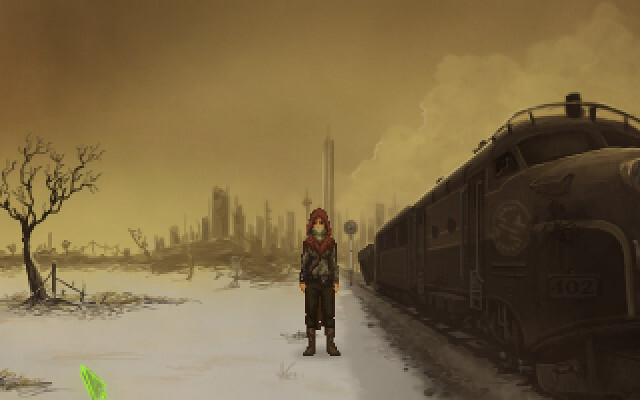Shardlight is a 2D point-and-click adventure game from Wadjet Eye Games, the creators of the Blackwell series and publishers of Technobabylon. Like the rest of Wadjet’s output, it was developed using a tool made in the late 90s to make games that look like they’re from the early 90s.1 It features Ben Chandler on pixels and Francisco González on writing, with both collaborating on design and programming.
Shardlight is named for the shards of uranium glass scattered around its environment, hung from trees and lampposts, which light most scenes with an eerie green glow. It’s vaguely hinted that this odd lighting has something to do with the after-effects of the cataclysm that put the apocalyptic in its post-apocalyptic setting, but the game doesn’t actually delve into that. On the commentary track Chandler admits that green shards were used because they looked cool, and that the name of the game was essentially a placeholder that stuck.
Fittingly, the game is full of stuff that looks cool but doesn’t entirely make sense. The unnamed city in which the game takes place is ruled by a government that literally calls itself The Aristocracy and dresses its officials and guards up in 18th century fashions complete with powdered wigs and condescension to the lower classes. It boggles the mind why any purportedly future government, especially one that presumably had to claw its way out of post-war chaos, would tempt the guillotines like that.2

It is a very striking aesthetic though, especially the painted gasmasks.
The lower classes, of which the player character is one, all dress in the rough, heavily layered and practical clothes of post-apocalyptic nomads despite not being in the least nomadic – all characters have homes in the same city. By contrast, the more well-to-do but not aristocratic dress quite normally – presumably the air pollution the main character needs to keep masking her face from only affects poor people. There’s a whole puzzle where you have to steal a set of clothing that’s essentially a less ragged recolour of your normal outfit. In the name of aesthetic, the question of why you couldn’t go home and change never comes up.
I’d be entirely happy to overlook these sacrifices of sense to style but for the game’s other failings. The outfit puzzle is not one of the game’s strongest, but it’s of the same spirit as most of the rest. While the Blackwell games strove to construct puzzles that make the player feel like they’re solving mysteries, and Technobabylon’s puzzles were used to flesh out the setting, Shardlight is content to let its puzzles be mere gates that must be passed through to unlock more of the story. Some of these gates are interesting in their own right, such as the clever and satisfying tactile puzzles, but many are rote and contrived obstacles, and few feel like organic parts of the story.

One of the obstacles in question.
Shardlight can also be maddeningly light on direction. A number of times during the game, I found myself at a complete loss for what to do next and had to refer to a walkthrough not to solve a puzzle but merely to figure out what puzzle I was supposed to be solving. This problem did lessen, however, as the game picked up momentum in its the final stretch.
When not occupied with fetch quests and needlessly complicated control panels, Shardlight’s story can be quite engaging. What initially seems like a clear-cut tale of scrappy, virtuous underdogs taking on an oppressive government headed by cartoon villains quickly turns out to be more nuanced and ambiguous. Not all of the villains’ reasoning rings true, and more could have been done to explore and elucidate the heroes’ flaws, but the narrative is pointed in the right direction. With a longer playtime, and puzzles more focused on actively engaging with the setting and characters, this could have been a very fine game indeed. As is, the setting feels bare; much like the titular shards of green light, the surface is initially intriguing but there’s no real depth to sustain much focused interest.
Sadly, this is not one of Wadjet Eye’s best. Aesthetically, Shardlight is brilliant. The pixel art is beautiful and it’s used to portray interesting-looking locations and people. The soundtrack is fitting and very well done. But the story and the puzzles, while having their moments, are more miss than hit. After finishing the game, I was left with the rather empty feeling that I wanted to like it much more than I actually did.

-
Not to discount the work of creator Chris Jones and subsequently numerous maintainers who have updated and even significantly rewritten AGS multiple times since 1997, with the latest release being a couple months ago. ↩︎
-
As with Fallout, Shardlight’s setting is the post-apocalypse of an alternate version of our world, as evinced by the main character calling 50s-looking cars by 2000s model numbers. It’s not clear precisely how alternate the setting is, and whether or not the French revolution happened, or if there even was a place called France. ↩︎
 David Yates.
David Yates.
 Francisco González 🌹💧 said on
0 September 2018:
Francisco González 🌹💧 said on
0 September 2018: